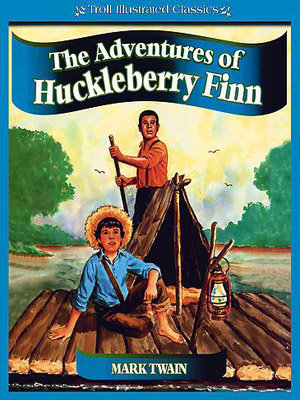
The Adventures of Huckleberry Finn is a novel written by Mark Twain. It was first published in 1883. It is the sequel to he Adventures of Tom Sawyer. The book uses several different elements such as: structure, plot, setting, characteristics, theme, style, diction, syntax, imagery, symbolism and tone. They are also intact with the 1890's era because it takes place when slavery was still around, as well as when the reconstruction era and new progression was around.
The three main characters are Huck Finn, Jim and Tom Sawyer. Huck is a boy still in his maturing phase of life. He is good-hearted and very gullible. He tries to become civilized but society does not suit him well because he is a very simple boy. Jim is a runaway slave and companion of Huck. He is like a father figure for Huck because his real father, Jim is more protective, caring and unselfish. Tom Sawyer is an older friend of Huck. Heis irresponsible, childish and outspoken. He is like a voyager or an adventurer. Tom contrasts with Huck by the fact that he lives in society and enjoys it.
The setting is along the Mississippi River. There are a couple of different themes. The major ones were the emphasis on the river as a way to escape from society and adventure. Te surroundings and the river separate Huck from society. There is growth with Huck throughout the story and his close encounters. After every encounter he learns something new about himself and people. Also that society is morally wrong. As he goes down the river he reflects on what has happened so far in his journey with Jim and realizes that all that has happened would not be accepted in society. For example helping a slave escape (Jim), that wouldn't be accepted. The style used was that of a boy and it was informal. It was very simple because everything was said through the eyes of a very young boy.
The tone of the story was informal but also funny. At times, when talking about society, it is very serious and straightforward. Twain shows this when he speaks about his dislike of the incidents where Pap was arrested or organized religion like the Sunday school picnics. During this time with Jim, Twain shows his dislike of slaver. He also uses imagery to create mood in the story. The obvious image would be Huck and the Mississippi River. The river is described as free flowing, untamed, and free just the way Huck wants to live. It is also relaxing and "mysterious". The story is told through Huck's mind and his diction is that of a southern boy during that era. It is definitely informal. He uses a lot of irony, humor, and imagery. The story is really just told as if Huck was talking directly to you. The syntax is both simple and informal. There is also a lot of slang used to make it informal. Everything is simple and original.
In this story Twain does not really use figurative language because Huck is the narrator. Also because of the fact that Huck is the narrator he can't use figurative language. It just doesn't fit the character of Huckleberry Finn. However. He does use metaphors and similes throughout the book. Personification is used when he refers to the steamboat. Also he uses allusions to other works like Hamlet and Romeo and Juliet. The greatest usage of symbolism is the river. It symbolizes freedom, independence and life to Huck throughout the story. It also acts as a utopia for Huck. He escapes the pressures of society to live freely on this river. Also Jim is a symbol for every slave in the South. Widow Douglass and Miss Watson represent society because they tried to civilize and change Huck just so he can fit into society, so he can be accepted.